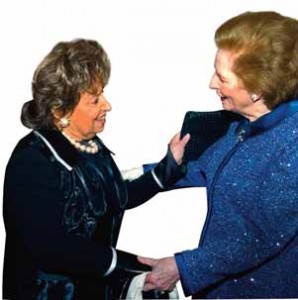 It is unusual to have so much laughter at a shivah, but there was plenty of laughter, mixed with tears, as the six children of Rebbetzin Lady Amelie Jakobovits sat shivah in London, following her petirah at the beginning of May. The rebbetzin’s home was packed with people who came to visit the mourners, each bringing a story of how “Lady J,” as she was affectionately known, had touched their lives. Family members passed around notebooks and even a tape recorder as individual after individual recounted incidents, which in themselves were not unusual or huge gestures, but added together made up a portrait of a life devoted to chesed and ahavat habriyot. The Jakobovits children, all grandparents themselves, said that the shivah was a celebration of their mother’s life, which was how she had seen the shivah following the petirah of their father,
It is unusual to have so much laughter at a shivah, but there was plenty of laughter, mixed with tears, as the six children of Rebbetzin Lady Amelie Jakobovits sat shivah in London, following her petirah at the beginning of May. The rebbetzin’s home was packed with people who came to visit the mourners, each bringing a story of how “Lady J,” as she was affectionately known, had touched their lives. Family members passed around notebooks and even a tape recorder as individual after individual recounted incidents, which in themselves were not unusual or huge gestures, but added together made up a portrait of a life devoted to chesed and ahavat habriyot. The Jakobovits children, all grandparents themselves, said that the shivah was a celebration of their mother’s life, which was how she had seen the shivah following the petirah of their father,
Lady J with Margaret Thatcher.
Photos: John R. Rifkin, Photographer, London
Rabbi Lord Immanuel Jakobovits, emeritus chief rabbi of Great Britain and the Commonwealth, some eleven years earlier.
The rebbetzin was a part of the fabric of Anglo-Jewry, involved in philanthropic work from Bikur Cholim d’Satmar to Emunah and everything in between. But the rebbetzin’s main focus was individuals. It was quite normal for the rebbetzin to make a shivah call armed with comfort, homemade challot and practical advice (such as not to cross one’s legs to avoid getting varicose veins). She made a daily list of people to call, ranging from an author of an article she appreciated to the future parentsin- law of a young man she had met, whom she called to tell what a lovely son-in-law they were acquiring.
Her husband had been a confidant of Margaret Thatcher when she was the prime minister, and Lady J remained friendly with Mrs. Thatcher. Such was the extent of her concern for people that she even phoned to inquire after the husband of Margaret Thatcher’s secretary, when she heard that he had been unwell. If she called an office and the receptionist was ill, she would call back a few days later to see how she was feeling. It was not unusual for the rebbetzin to continue making calls until late at night; and as her grandson related at the levayah in Jerusalem, one erev Pesach, she made 600 calls to wish people good yom tov! The rebbetzin was also a prolific letter writer, dropping notes to wish people mazal tov or thank them for a favor they had done for her.
Lady J had been raised to do chesed. At the shivah, one woman recalled that when her grandmother arrived in Paris after World War II, she was greeted at the train station by a young girl holding a basket of oranges. She had never seen an orange before and bit straight into the skin. Many years later, she was telling this story and Lady J said with surprise that she had been the girl with the oranges. Lady J’s father had sent her to the station to greet the forlorn refugees, and offer them something to eat.
Lady J was born in 1928, the eldest child of Rabbi Elie Munk, rabbi of Ansbach, Germany, and his wife, Fanny. In 1936, Rabbi Munk left Nazi Germany to serve as the rabbi in the Adas Yereim shul in Paris. Following the German invasion of France in 1940, the family escaped to Switzerland, and returned to Paris in August 1945.
 Lady J with children from the North West London Jewish Day School.
Lady J with children from the North West London Jewish Day School.
When Lady J was nineteen, she was introduced to Rabbi Immanuel Jakobovits, who at the age of twenty-seven, had been appointed chief rabbi of Ireland. They were married, and a short time later, moved to New York, where Rabbi Jakobovits became the first rabbi of the Fifth Avenue Synagogue. The rebbetzin had to adapt to the different community she found in New York, but did so with her typical flair and hard work, calling and visiting people, while also focusing on raising her family.
In 1966, Rabbi Jakobovits was called back to Europe to serve as the chief rabbi of Great Britain and the Commonwealth, a position he was to hold until his retirement in 1991. The Jakobovitses regarded the chief rabbinate as a family enterprise: one facet of the job was spending Shabbat in different communities. The rebbetzin was only prepared to travel for Shabbat if space could be found for the entire family. This was counter balanced by regular Shabbatot when the family stayed home with no guests in order to spend time together.
In 1981, Chief Rabbi Jakobovits was knighted and the rebbetzin became Lady Jakobovits. The English honors system had formalized what the kehillah in England already knew—the chief rebbetzin was a lady through and through. Always immaculately dressed, in a stylish yet modest way, Lady J had tremendous chen—charm and had joie de vivre throughout her life.
During the shivah, when the family opened the small aron kodesh located in Lady J’s house to prepare for the minyanim during the shivah, they were astounded to find four siddurim neatly stacked—one for each daughter. They were siddurim from significant events in the rebbetzin’s life and she left notes in them for each daughter. She had wanted to comfort them, knowing what a loss her passing would present. As everything in her life was a partnership between herself and her husband, the rebbetzin wrote the messages from both of them.
Lady J left behind a legacy, not just of a large, loving family, all involved in transmitting the mesorah in some way, but also of a kehillah, touched by the cumulative small deeds of a special lady.
Vicki Belovski, wife of Rabbi Harvey Belovski, is the rebbetzin of Golders Green Synagogue, the community news editor of Hamodia UK and a freelance writer. She lives in London with her family.